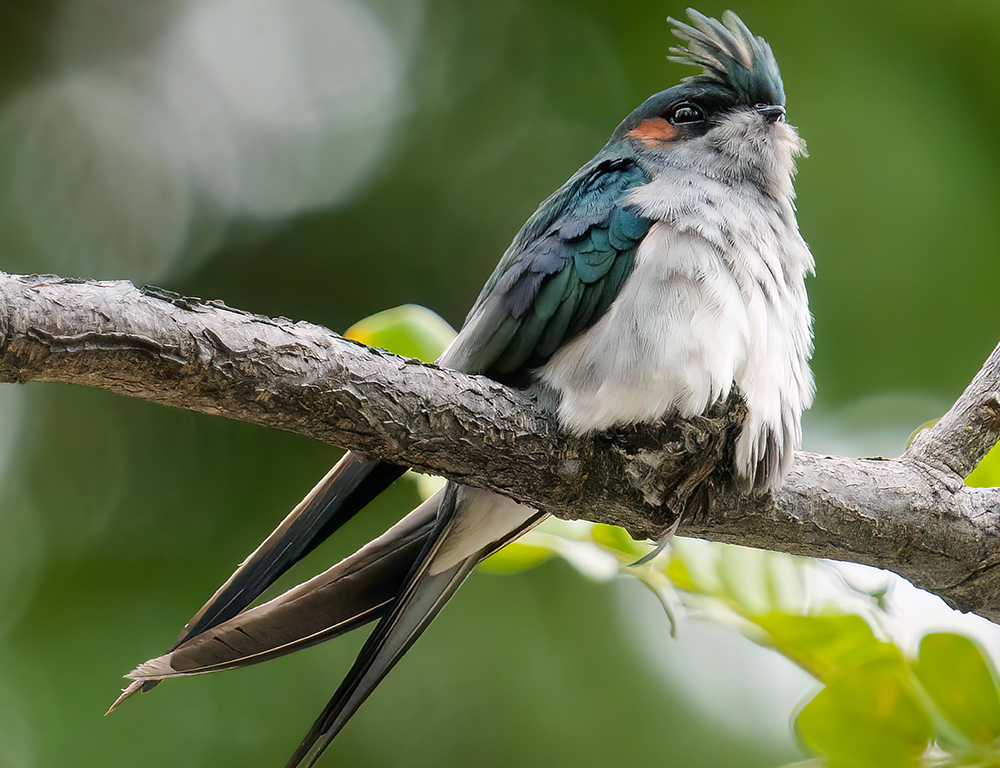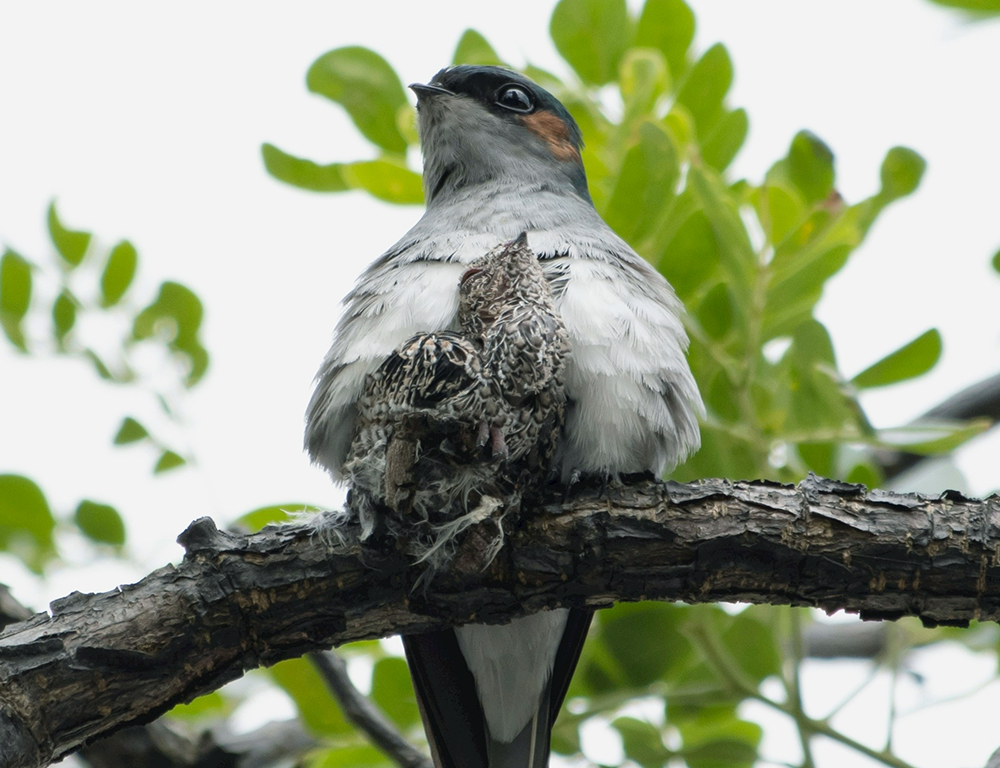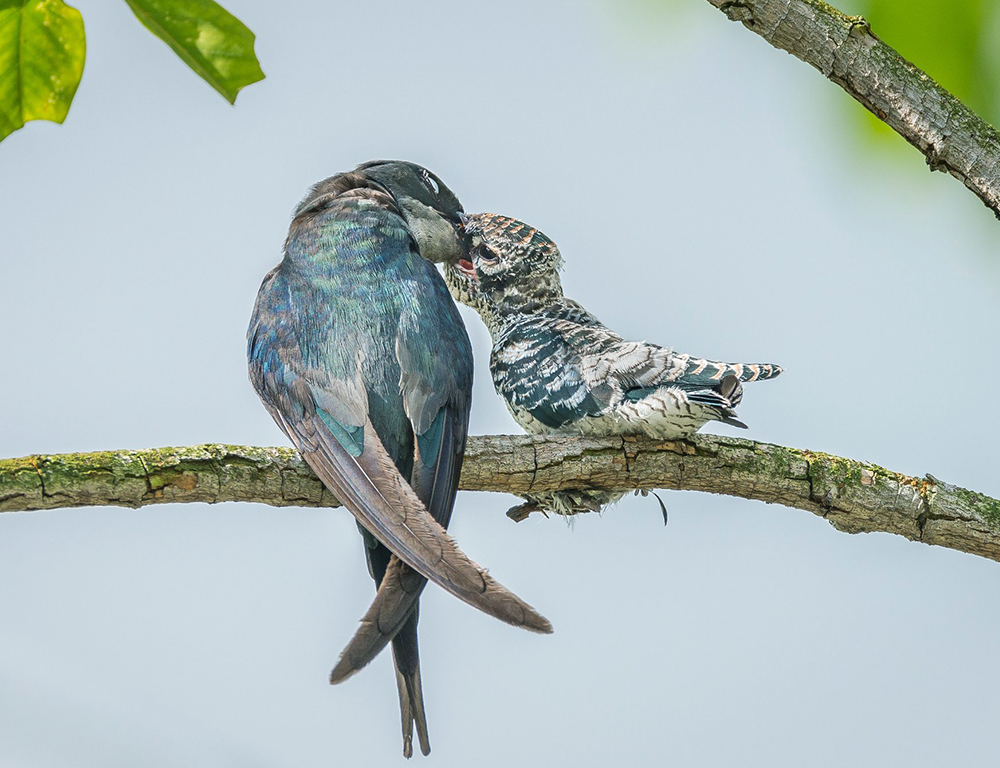Sweeping through the lush tropical rainforests of Southeast Asia, the Grey-Rumped Treeswift captivates with its striking physical features and distinctive lifestyle.
With its elongated wings, slender frame, and unmistakable grey-rumped appearance, this bird stands out as a remarkable sight in the canopy.
However, its allure extends beyond mere aesthetics; the Grey-Rumped Treeswift’s adaptation for swift and agile flight is truly fascinating.
Evolving into incredible aerial hunters, they navigate dense forests with unparalleled precision, utilizing their pointed bills to snatch insects mid-flight.
Moreover, their unconventional nesting behavior sets them apart, as they defy convention by laying a single egg directly onto bare tree branches.
While seemingly precarious, this daring choice serves as a strategic defense against predators while facilitating rapid take-offs.
The Grey-Rumped Treeswift epitomizes nature’s ingenuity, making it a subject of enduring fascination and admiration.

Physical Characteristics of the Grey-Rumped Treeswift
The Grey-Rumped Treeswift (Hemiprocne longipennis) possesses several physical characteristics that distinguish it from the avian world:
Size
Grey-rumped treeswifts are relatively large compared to many other swift species, with males typically measuring around 23 centimeters (9 inches) in length and females slightly smaller at about 21 centimeters (8 inches).
Their wingspan is approximately 36 centimeters (14 inches), enabling them to navigate efficiently through the forest canopy.
Body Structure
These birds have a sleek and slender body structure, well-suited for their aerial lifestyle. Their streamlined bodies allow them to move swiftly through the air with minimal air resistance.
Their long, narrow wings enhance their flight capabilities, enabling them to perform agile maneuvers while hunting for mid-air insects.
Coloration
The Grey-Rumped Treeswift derives its name from the distinctive grey coloration of its rump. The rest of its plumage is predominantly chestnut-colored on the upperparts, with a glossy green sheen.
The underparts are typically creamy-white. Male Grey-Rumped Treeswifts may exhibit additional markings, such as a black submoustachial stripe, which adds to their visual appeal.
Wings and Flight
One of the most remarkable features of the Grey-Rumped Treeswift is its long and pointed wings. These wings are specialized for swift and sustained flight, allowing the birds to glide effortlessly through the forest canopy.
Their flight patterns are characterized by rapid and direct movements, making them highly efficient hunters of flying insects.
Bill
Grey-rumped treeswifts have a sharply pointed bill, well-adapted for capturing insects mid-flight. Their bills enable them to snatch prey precisely while maneuvering through the air at high speeds.
Overall Appearance
With its elegant body structure, distinctive coloration, and elongated wings, the Grey-Rumped Treeswift presents a striking appearance. These physical characteristics contribute to its visual beauty and reflect its specialized adaptations for life in the forest canopy.
Habitat and Distribution of the Grey-Rumped Treeswift

The Grey-Rumped Treeswift (Hemiprocne longipennis) is primarily found in Southeast Asia’s tropical and subtropical forests. Here’s an overview of its habitat and distribution:
Habitat
The Grey-Rumped Treeswift (Hemiprocne longipennis) primarily inhabits various forested environments in Southeast Asia. Here’s an overview of its habitat:
Tropical and Subtropical Forests
Grey-rumped treeswifts are commonly found in tropical and subtropical moist lowland forests. These lush, dense forests provide abundant vegetation and a diverse array of insect prey, essential for the treeswift’s survival.
They prefer habitats with tall trees, especially those with dense foliage, where they can easily navigate and forage for food.
Mangrove Forests
Besides terrestrial forests, Grey-Rumped Treeswifts also inhabit mangrove forests along coastal areas. Mangrove ecosystems offer a unique habitat with a mix of terrestrial and aquatic environments, providing opportunities for foraging and nesting.
Urban and Human-Altered Habitats
Grey-rumped treeswifts have shown some adaptability to human-altered environments. They are occasionally spotted in urban areas, including parks, gardens, and plantations, especially if suitable food sources are available.
However, their presence in such habitats often depends on preserving tree cover and adequate prey populations.
Distribution
The Grey-Rumped Treeswift (Hemiprocne longipennis) is distributed across Southeast Asian countries. Here’s a breakdown of its distribution by country:
Indonesia
Grey-rumped treeswifts throughout Indonesia, including Sumatra, Java, Sulawesi, and the Lesser Sunda Islands. Indonesia hosts a significant portion of the species’ population, with estimates exceeding 500,000 individuals.
Malaysia
Grey-rumped treeswifts are found across Malaysia, including Peninsular Malaysia and the islands of Borneo and Sumatra. They inhabit various forested habitats within Malaysia, from lowland rainforests to montane forests.
Thailand
Grey-rumped treeswifts are present in Thailand, particularly in the southern and western regions of the country. They are commonly found in tropical and subtropical forests and mangrove habitats along the coast.
Myanmar
Grey-rumped treeswifts occur in Myanmar, primarily in the southern and western parts of the country. They inhabit various forested habitats, including lowland rainforests and mangrove forests along the coast.
Brunei
Grey-rumped treeswifts are also found in Brunei, where they inhabit forested areas nationwide. They are ubiquitous in the lowland rainforests of Brunei.
Here are some population statistics broken down by country:
| Country | Population Estimate |
|---|---|
| Myanmar | 10k-100k |
| Thailand | 10k-100k |
| Malaysia | 10k-100k |
| Singapore | <1K |
| Indonesia | >500K |
Behavior of Grey-Rumped Treeswifts
The behavior of the Grey-Rumped Treeswift (Hemiprocne longipennis) is characterized by a combination of unique traits and adaptations that enable it to thrive in its forest habitat.
Here are some key aspects of their behavior:
Diet and Feeding Habits

Grey-rumped treeswifts are primarily insectivorous, with their diet consisting mainly of flying insects such as beetles, wasps, and spiders. They are adept aerial hunters, utilizing their agile flight and sharp vision to catch prey mid-flight.
These birds are often observed darting through the forest canopy, making rapid and precise maneuvers as they pursue their insect prey.
| Favorite Insect Prey | Frequency |
|---|---|
| Beetles | 60% |
| Wasps | 25% |
| Spiders | 15% |
Nesting Behavior
Nesting behavior in Grey-Rumped Treeswifts is noteworthy for its simplicity and efficiency. Unlike many other bird species that construct elaborate nests, Grey-Rumped Treeswifts typically lay their eggs directly onto a thin branch without any nesting material for cushioning.
The single egg is carefully positioned on a bare branch, often overhanging water or the forest floor. Both male and female birds take turns incubating the egg, demonstrating a shared responsibility for parental care.
Flight Pattern
Grey-rumped treeswifts are renowned for their swift and agile flight. They have long, narrow wings that enable them to glide effortlessly through the forest canopy, precisely navigating complex environments.
Their flight patterns are characterized by rapid and direct movements, allowing them to cover large distances in search of food or suitable nesting sites. They can also make sudden turns and dives mid-flight, demonstrating their agility and maneuverability.
Territorial Behavior
Grey-rumped treeswifts are known to defend territories, particularly during the breeding season. Males may engage in aerial displays or vocalizations to establish and maintain territory boundaries.
These territories are essential for securing access to resources such as food and nesting sites, and individuals may vigorously defend them against intruders.
Social Structure
Grey-rumped treeswifts are generally observed in pairs or small family groups, particularly during breeding. They may form loose aggregations or flocks outside the breeding season, particularly around abundant food sources.
However, they are not highly social birds and typically maintain a degree of separation from other individuals.
Conservation Status of Grey-Rumped Treeswift

The conservation status of the Grey-Rumped Treeswift (Hemiprocne longipennis) is currently classified as “Least Concern” by the International Union for Conservation of Nature (IUCN).
This classification suggests that the species is not facing imminent extinction threats but does not imply that conservation efforts are unnecessary.
Here’s an overview of the conservation status of the Grey-Rumped Treeswift:
Population Trend
The Grey-Rumped Treeswift’s population trend is relatively stable, with no significant declines reported in recent years.
However, precise population data for this species are limited, and further research may be needed to assess population trends across its range accurately.
Population Size
Estimates of the Grey-Rumped Treeswift’s population vary, with BirdLife International providing a wide range of 670,000 to 6.7 million mature individuals in the wild. These estimates suggest the species maintains a relatively large and healthy population size.
Threats
While the Grey-Rumped Treeswift is currently classified as “Least Concern,” it faces several threats that could impact its long-term survival.
Habitat loss and degradation due to deforestation, urbanization, and agricultural expansion are significant concerns, particularly in Southeast Asia, where the species is found.
Loss of forest habitat reduces available nesting sites and foraging areas for the treeswift, potentially leading to population declines over time.
Conservation Efforts
Conservation efforts focused on preserving and restoring the forest habitats of the Grey-Rumped Treeswift are essential for ensuring its continued survival.
Protected areas and conservation initiatives aimed at safeguarding forest ecosystems can help mitigate the impacts of habitat loss and provide essential habitat for the species.
Additionally, raising awareness about the importance of biodiversity conservation and engaging local communities in conservation efforts can contribute to protecting the Grey-Rumped Treeswift and its habitat.
Future Considerations
While the current conservation status of the Grey-Rumped Treeswift is relatively favorable, ongoing monitoring and research are crucial for assessing population trends and identifying emerging threats.
Continued efforts to conserve forest habitats and address key conservation challenges will be essential for maintaining healthy populations of this species and preserving biodiversity in Southeast Asia.
FAQs
How fast can the Grey-Rumped Treeswift fly?
Grey-rumped treeswifts are known for their rapid and agile flight, reaching up to 40 miles per hour (64 kilometers per hour).
What is the lifespan of a Grey-Rumped Treeswift?
The average lifespan of a Grey-Rumped Treeswift in the wild is around 5 to 7 years.
Are Grey-Rumped Treeswifts solitary birds?
Grey-rumped treeswifts are typically observed in pairs or small groups, especially during the breeding season. However, they may also be solitary while foraging or roosting.
Do Grey-Rumped Treeswifts migrate?
Grey-rumped treeswifts are largely sedentary birds, meaning they do not undertake long-distance migrations. However, some individuals may make local movements in response to seasonal changes or fluctuations in food availability.
How do Grey-Rumped Treeswifts communicate with each other?
Grey-Rumped Treeswifts use vocalizations, such as calls and chirps, to communicate with members of their group. These vocalizations are often used for maintaining contact, signaling alarm, or during courtship displays.
Conclusion
The Grey-Rumped Treeswift is a captivating symbol of nature’s ingenuity and resilience. Its remarkable adaptations for flight, nesting, and hunting showcase the beauty of evolutionary processes.
As avid observers, we are reminded of the intricate tapestry of life and the importance of biodiversity conservation. Studying these swift flyers offers insights into our planet’s ecosystems and underscores the need to preserve their habitats for future generations.
Let us remain vigilant in our efforts to protect these unique avian species, recognizing that every bird, including the Grey-Rumped Treeswift, plays a vital role in maintaining ecological balance.
Together, let’s continue our journey of exploration, study, and conservation, honoring the wonder of our winged neighbors.